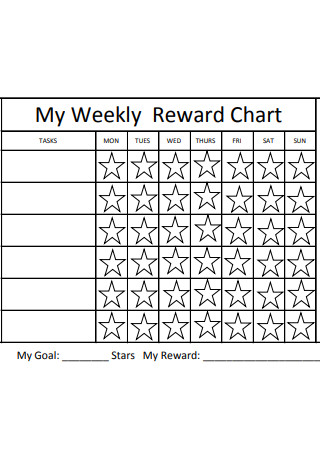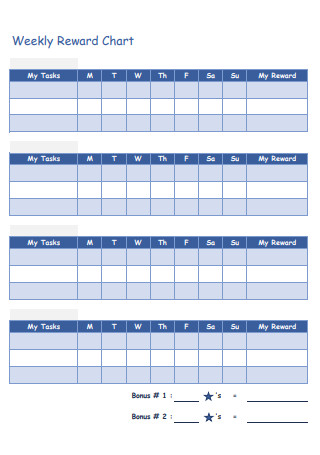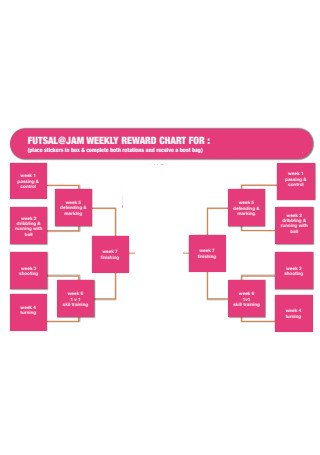3+ Sample Weekly Reward Chart
We have prepared 4 reward chart samples for you to get a glimpse of how it visually looks and that are totally easy to replicate and ones you may have full control of customizing to fit your situation.
What is a Reward Chart?
Firstly, a rewards chart is anything that can be used to record positive behaviors and reward them accordingly. It is likely to be used when there is a certain goal you have in mind that you want to be achieved which in most cases, can be active participation in the accomplishment of class projects or a game that you want your team to win. A rewards chart records the progress made through creative and fun ways that can even make use of flashy and bright art materials, trinkets, or stickers of a favorite fictional characters that adds a personal touch to the reward chart thus making it familiar. But a visible tallying of behavior and progress is only one part of the rewards chart and it can only hold a one’s attention for so long.
What seals the deal and makes individuals commit to making consistent efforts to reach the established goals are the rewards that they get when it is reached. These can be rewards that they can physically enjoy or rewards that touch on their emotive aspects forming long-term memories that they could look back on fondly. Accumulated mini-rewards will build up enough anticipation that warrant determination to keep practicing good behaviors. These rewards can come in different forms such as a good staycation for your team, movie tickets to blockbuster hits and any positive and tangible reinforcements to show their efforts are recognized.
Pros & Cons of a Rewards Chart
Pros: Kids actually work. Groupworks get done days before the deadline. The goals are reached.
Cons: Usual rewards are no longer rewarding enough, they think good deeds are incentivized, they may develop fear of committing a mistake and the pressure to always act on their best, they may rely on material things and people’s validation before they acknowledge they are just as worth it without them.
It’s not exactly rewarding, huh? Because while daily rewards for a positive behavior would be a nice way to truly show that efforts are appreciated, studies reveal that it can end up being counterproductive and prove to be harmful in the long run. In an article written by Richard Curwin, he cites six (6) reasons why the reward system does not work and they are as follows: satiation, addiction, finishing, manipulation, increased pressure and bribes.
Satiation: Kids start wanting more. A sticker that used to make their day just won’t cut it. An ice cream won’t be enough. Even compliments won’t give the same effect as they once did as it can be overdone and may seem deceitful.
Addiction: Tasks will only be done if it meant getting a reward in return. After feeling like the usual rewards don’t give off the same satisfaction, we start to have a better sense of what could give us the same rush and it might lead us to not work unless it’s promised to us.
Finishing: Kids become “finishers rather than learners.” A system that rewards every positive act perpetuates the harmful idea of only doing the task if it means a reward in return making the act ingenuine and if there is anything we don’t want to teach anyone, it’s to be insincere. This also robs the kids of an inherent desire to do good which is the last thing we want for them.
Manipulation: Kids respond negatively to manipulation. One can say the reward system is manipulative but only if it is unchecked. However most times, it does get ignored and when someone is exposed to this early on and gets used to it, it may be disorienting when they arrive at a time of unlearning these.
Increased pressure: Kids become insecure. Obviously, it is expected that we become good people who do good things as much as possible. But, if a someone grows up being complimented for only good behavior, they might form a dependency on these compliments that they feel the pressure to do good to get that validation.
Bribes: Kids are left to not make choices of their own. A reward system is another way of saying you want to control someone and this control is manifested when you get someone to perform as you wish through the rewards you have set for them.
How to Make Reward Charts Work
While there are certainly cons, reward charts have benefits that produce long-lasting good habits that make the application of a reward chart worth a try. However, a reward chart will only be deemed effective if it is used wisely and is closely monitored, that interventions from the adults are made as soon as it is necessary, and most importantly when the whole process is dealt with patience and tenderness. The following are ways for reward charts to work:
FAQs
What Should Be Included in a Weekly Reward Chart?
A reward chart may include the specified behavior you want your student to practice or the goals you want them to accomplish such as keeping track of their homework or paying attention to the discussion. You may also indicate the length of the time the student has to do the task for them to get the reward which you could also mention as well. For kids, the reward chart can have stickers as inclusions to get their attention.
How Do I Reward My Students?
Rewarding is actually the easiest part of having a reward chart as you are free to choose which rewards you think your student deserves best for as long as you know it is something they will enjoy. It may come in different forms and a highly encouraged ones are always praises and compliments that you can give immediately. Generally, rewards are a trip to the zoo or the arcade, a comic book, a treat to their favorite fast food chain. You may also give them the option to pick something they like for themselves.
Are Reward Charts a Good Idea?
While we did present consequences to using a reward chart for your kids, keep in mind that this is a method grounded on a rewards system that according to Psychology Today has proven to work. Albeit traditional and catered to kids, reward charts have been improved for all ages to use and countless ways to make it work are available on the Internet for you to adopt.
When used properly, a reward chart won’t just merely improve your student’s behavior but it could inculcate the values of volunteerism and collective effort as well as honing integral life skills such as taking responsibilities and accomplishing them in their own pace.




